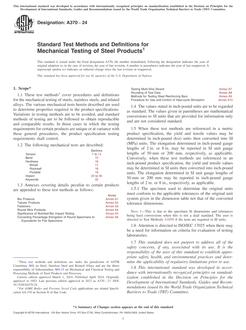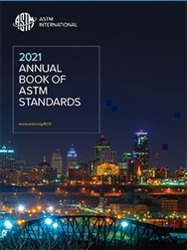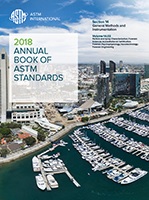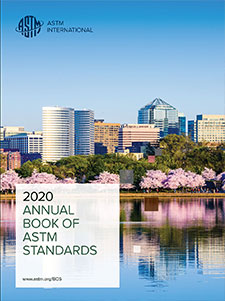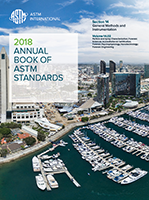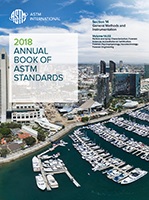Description
1.1 These test methods2 cover procedures and definitions for the mechanical testing of steels, stainless steels, and related alloys. The various mechanical tests herein described are used to determine properties required in the product specifications. Variations in testing methods are to be avoided, and standard methods of testing are to be followed to obtain reproducible and comparable results. In those cases in which the testing requirements for certain products are unique or at variance with these general procedures, the product specification testing requirements shall control.
1.2 The following mechanical tests are described: Sections Tension 7 to 14 Bend 15 Hardness 16 Brinell 17 Rockwell 18 Portable 19 Impact 20 to 30 Keywords 32
1.3 Annexes covering details peculiar to certain products are appended to these test methods as follows: Annex Bar Products Annex A1 Tubular Products Annex A2 Fasteners Annex A3 Round Wire Products Annex A4 Significance of Notched-Bar Impact Testing Annex A5 Converting Percentage Elongation of Round Specimens to
Equivalents for Flat Specimens Annex A6 Testing Multi-Wire Strand Annex A7 Rounding of Test Data Annex A8 Methods for Testing Steel Reinforcing Bars Annex A9 Procedure for Use and Control of Heat-cycle Simulation Annex A10
Equivalents for Flat Specimens Annex A6 Testing Multi-Wire Strand Annex A7 Rounding of Test Data Annex A8 Methods for Testing Steel Reinforcing Bars Annex A9 Procedure for Use and Control of Heat-cycle Simulation Annex A10
1.4 The values stated in inch-pound units are to be regarded as standard. The values given in parentheses are mathematical conversions to SI units that are provided for information only and are not considered standard.
1.5 When these test methods are referenced in a metric product specification, the yield and tensile values may be determined in inch-pound (ksi) units then converted into SI (MPa) units. The elongation determined in inch-pound gauge lengths of 2 in. or 8 in. may be reported in SI unit gauge lengths of 50 mm or 200 mm, respectively, as applicable. Conversely, when these test methods are referenced in an inch-pound product specification, the yield and tensile values may be determined in SI units then converted into inch-pound units. The elongation determined in SI unit gauge lengths of 50 mm or 200 mm may be reported in inch-pound gauge lengths of 2 in. or 8 in., respectively, as applicable.
1.5.1 The specimen used to determine the original units must conform to the applicable tolerances of the original unit system given in the dimension table not that of the converted tolerance dimensions.
Note 1: This is due to the specimen SI dimensions and tolerances being hard conversions when this is not a dual standard. The user is directed to Test Methods A1058 if the tests are required in SI units.
1.6 Attention is directed to ISO/IEC 17025 when there may be a need for information on criteria for evaluation of testing laboratories.
1.7 This standard does not purport to address all of the safety concerns, if any, associated with its use. It is the responsibility of the user of this standard to establish appropriate safety, health, and environmental practices and determine the applicability of regulatory limitations prior to use.
1.8 This international standard was developed in accordance with internationally recognized principles on standardization established in the Decision on Principles for the Development of International Standards, Guides and Recommendations issued by the World Trade Organization Technical Barriers to Trade (TBT) Committee.

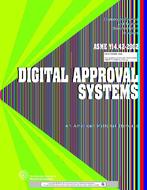 ASME Y14.42-2002 (R2008)
ASME Y14.42-2002 (R2008) 

